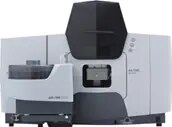Environmental Solutions
Shimadzu Atomic Absorption
Atomic absorption spectrophotometers measure concentrations of metals and semi-metals in low ppb to ppm levels. Free atoms absorb element-specific radiation emitted by a lamp. Atomization can be in a flame, a graphite furnace, a heated tube, or generation of vapor.
Flame AA
Flame AA detection limits range from about 1 to 100 parts per billion depending on the element. The liquid sample is aspirated into a nebulizer and smaller droplets are drawn into a flame. Elements atomize in the flame. Element-specific light, passing through the flame, is absorbed by the free atoms in proportion to their concentration.
Flame AA is not a complex instrument and very easy for non-technical people to run. If you only have a few elements, such as iron, manganese, and copper, to run, then flame AA is an instrument of choice. Flame AA only runs one element at a time. You would run your iron, change the lamp, then your copper, and so forth.
Graphite Furnace AA
Graphite furnace AA adds a modifier to the sample then injects it directly into a carbon tube. Current applied to each end of the tube heats it. First to dry the sample, then char, then atomization. The charring step removes interferences without volatilizing the analyte. The modifier raises the charring temperature. Once charring is complete, the temperature rises rapidly, producing a signal as the atomized element of interest absorbs the element specific wavelength.
Furnace AA has very low detection limits. It is slower than flame AA per reading and only measures one element at a time. Different elements may require different graphite tubes and different modifiers. Use furnace AA for elements with detection limits lower than possible by flame AA.
Hydride Generation and Cold Vapor AA
Hydride generation has an advantage over furnace AA in that it completely removes the analyte from the matrix for measurement. Use hydride AA for arsenic and selenium in high TDS samples. As with other AA methods, you only measure one element at a time. Unlike other AA methods that can be run from a single sample digestion, As and Se require separate preparation steps prior to hydride generation. This adds to the cost of analysis. In hydride generation, the As or Se are converted to hydrides by adding sodium borohydride. A carrier gas, sweeps the gaseous hydride into a heated quartz tube where it is atomized. The atoms absorb element-specific light in proportion to concentration. Mercury is not converted to a hydride, but is measured in a similar fashion. Mercury also requires a separate digestion. Stannous chloride or sodium borohydride are added and mercury vapor is swept by a carrier gas into a non-heated tube. The mercury atoms absorb light in proportion to their concentration.
Hydride and cold vapor also have low detection limits. The techniques serve to separate the analyte from the matrix, minimizing interferences. Each requires a separate digestion and a separate analysis. Because of severe matrix interferences that can happen by furnace AA, you may need hydride generation of As and Se in some samples. Because of the separate digestions and analysis, hydride generation is a slow and labor-intensive technique.
Table 1 lists examples of methods that require the use of atomic absorption spectrophotometers. The Standard Methods for the Examination of Water and Wastewater methods are multi-element. EPA methods, with the exception of EPA 200.9 (a graphite furnace method), are element specific.
Table1: Examples of AA methods
| Method | Analyte | Atomization |
|---|---|---|
| SM 3111 A | Most metals | Flame |
| SM 3111 D | Refractory metals | Nitrous flame |
| SM 3113 B | Trace metals | Furnace |
| SM 3114 B&C | As and Se | Hydride |

Other Solutions
- Atomic Absorption
- Balances
- Energy Dispersive XRF
- Gas Chromatography
- GCMS
- Gas Chromatography Tandem Mass Spectrometry
- HPLC
- ICP/AES
- ICP/MS
- Ion Chromatography
- LCMS
- MALDI iD-Plus
- On-Line Analyzers
- Spectrophotometers
- Total Nitrogen Analyzers
- Total Organic Carbon Analyzers (TOC)
- Return to Environmental Top Page


